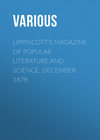Kitabı oku: «Scientific American, Volume 40, No. 13, March 29, 1879», sayfa 6
GLASS SPONGES
The natural history of sponges had, up to the middle of this century, been comparatively neglected. Until 1856, when Lieberkuhn published his treatise on sponges, very little or nothing had been written on the subject. Later, Haeckel did much to determine their exact nature, and it is now universally admitted that sponges form one of the connecting links between the animal and the vegetable kingdom.
Sponges, generally considered, consist of fine porous tissue, covered, during life, with viscid, semi-liquid protoplasm, and are held in shape and strengthened by a more or less rigid skeleton, consisting chiefly of lime or silica. The tissue consists of a very fine network of threads, formed probably by gradual solidification of the threads of protoplasm. The inorganic skeleton is formed by larger and smaller crystals and crystalline threads. In the various families of sponges the quantity of inorganic matter varies greatly; some sponges are nearly devoid of an inorganic skeleton, while other families consist chiefly of lime or silica, the organic tissue being only rudimentarily developed.
As observed in their natural state, sponges are apparently lifeless. When, however, a live sponge is placed in water containing some finely powdered pigment in suspension, it will be noticed that in regular, short intervals water is absorbed through the pores of the tissue and ejected again through larger openings, which are called "osculæ." Following up these into the interior, we find them divided into numerous branches, the walls of which are, under the microscope, found to be covered with minute cells, fastened at one end only and oscillating continually. By means of these cells the sponge receives its nourishment.
Sponges with very rigid inorganic skeletons may be divided into two classes—calcareous and silicious—according to whether the skeleton is chiefly composed of lime or silica.
Our engravings represent two species of the latter kind, which are, on account of the peculiar appearance of their skeleton, called glass sponges.
Fig. 1 represents the "sprinkling pot sponge," Eucleptella aspergillum. It is generally found in very deep water throughout the Pacific. Specimens were found over fifty years ago, but, as they had to be brought up from depths between 500 and 800 fathoms, they remained very scarce and sold at fabulous prices.

Fig. 1.—SPRINKLING POT SPONGE.—(Eucleptella aspergillum.)
The skeleton is formed by small crystals and long threads of vitreous silica, cemented together, during life, by protoplasm. They are arranged in longitudinal and annular bands so as to form a long curved cylinder, about nine to twelve inches long, the walls of which are about one inch in thickness. The threads and bands are interwoven with the greatest regularity, and when the skeleton is freed from the adhering organic matter, it looks extremely beautiful.
The mode in which the intersecting bunches of crystals are connected is shown in Fig. 2. The upper end of the cylinder is closed by a perforated cover, which probably has given rise to the name of the sponge. The upper portion of the cylinder is surrounded by a few irregular, annular masses of organic tissue, which adheres loosely only to the skeleton. The lower end is formed by a bunch of long threads, rooting firmly in the ground.

Fig. 2.—SPONGE CRYSTALS MAGNIFIED.
Up to about ten years ago the price of specimens of this sponge was very high. At that time, however, a colony of Eucleptellas was found near the cities of Cebu and Manila, in the East Indies, in a depth not exceeding 100 fathoms, and since they have appeared in larger quantities in the market. It is remarkable that, contrary to their habits, these organisms have immigrated into regions to which they were totally unaccustomed. Yet it must be regarded as a greater curiosity that they have been accompanied to their new abode by a few animals living in equally deep water and never met with before at depths less than three or four hundred fathoms. Among these animals is a Phormosoma (water hedgehog), noted for its long spines.
Glass sponges are not confined to tropical regions. They are met with in latitudes as high as the Färöe Islands, where the beautiful Holtenia Carpentaria abounds. It is represented in Fig. 3. Its cup-shaped skeleton is similar in structure to that of the Eucleptella; numerous crystalline needles protrude from the surface of the upper part. Lately some specimens of Holtenia have been found on the coast of Florida.

Fig. 3.—HOLTENIA CARPENTERIA.
Glass sponges serve as dwellings for numerous animals, especially crustaceæ. A small shrimp inhabits the tubes of the Eucleptella, a male and a female generally living together. They are shut up as in a prison in their crystalline home, as they are generally too large to pass through the meshes formed by the bundles of crystals. It was formerly believed that these skeletons had actually been built by the shrimps, and we can find no explanation for this curious circumstance, other than that the shrimps entered these habitations while very small and became too large to leave them.
Plants Protected by Insects
Mr. Francis Darwin, in a lecture on "Means of Self-Defense among Plants," delivered lately at the London Institution, said that one of the most curious forms of defense known is afforded by a recently discovered class of plants, which, being stingless themselves, are protected by stinging ants, which make their home in the plant and defend it against its enemies. Of these the most remarkable is the bull's-horn acacia (described by the late Mr. Belt in his book "The Naturalist in Nicaragua"), a shrubby tree with gigantic curved thorns, from which its name is derived. These horns are hollow and tenanted by ants, which bore a hole in them, and the workers may be seen running about over the green leaves. If a branch is shaken the ants swarm out of the thorns and attack the aggressor with their stings. Their chief service to the plant consists in defending it against leaf-cutting ants, which are the great enemy of all vegetation in that part of America. The latter form large underground nests, and their work of destruction consists in gathering leaves, which they strip to form heaps of material, which become covered over with a delicate white fungus, on which the larvæ of the ants are fed, so that literally they are a colony of mushroom growers. The special province of the little stinging ants, which live in the thorns of the acacia, is, therefore, to protect the leaves of the shrub from being used by the leaf-cutters to make mushroom beds. Certain varieties of the orange tree have leaves which are distasteful to the leaf-cutters, this property of the leaves thus forming a means of defense. Other plants are unaccountably spared by them—grass, for example, which, if brought to the nest, is at once thrown out by some ant in authority. The bull's-horn acacia, in return for the service rendered by the stinging ants, not only affords them shelter in its thorns, but provides them with nectar secreted by glands at the base of its leaves, and also grows for them small yellow pear-shaped bodies, about one twelfth of an inch in length, at the tip of some of its leaflets, which they use as food. These little yellow bodies are made up of cells containing protoplasm rich in oil, and afford the insects an excellent food. When the leaf unfolds, the ants may be seen running from one leaflet to another, to see if these little yellow bodies are ripe; and if they are ready to be gathered they are broken up by the ants and carried away to the nest in the thorn. Several small birds, also, build their nests in the bull's horn acacia, thus escaping from a predatory ant which is capable of killing young birds. The trumpet tree, another plant of South and Central America, is also protected by a standing army of ants; and, like the above mentioned acacia, grows for its protectors small food bodies containing oil, but instead of secreting nectar in its leaves it harbors a small insect (coccus), whose sweet secretion is much relished by the ants. Dr. Beccari mentions an epiphytal plant growing on trees in Borneo, the seeds of which germinate, like those of the mistletoe, on the branches of the tree; and the seedling stem, crowned by the cotyledons, grows to about an inch in length, remaining in that condition until a certain species of ant bites a hole in the stem, which then produces a gall-like growth that ultimately constitutes the home of the ants. If the plant is not fortunate enough to be bitten by an ant it dies. These ants, then, protect their plant home by rushing out fiercely on intruders, and thus are preserved the sessile white flowers which, in this plant, are developed on the tuber like body.
Advance in Iron.—At a meeting of the Philadelphia Iron Merchants' Association, March 11, prices of all descriptions of merchant iron were advanced fully 5 per cent.
The Aneroid Barometer
The aneroid barometer was invented by M. Vidi, of Paris. It consists essentially of a circular box, the face of which is made of thin elastic metal, rendered more elastic by being stamped and pressed into concentric circular wave-like corrugations. This box is nearly exhausted of air, and its elastic face supports the pressure of the atmosphere, and yields to it with elastic resistance in proportion to the amount of pressure. Thus, if the atmospheric pressure increases, the face is pressed inward; if atmospheric pressure diminishes, the elastic reaction of the metal moves the face outward. These movements are communicated to an index by suitable and very delicate mechanism, and registered in largely magnified dimensions, by the movements of this index upon the face of the dial.
Aneroid barometers are now made of pocket size, compensated for temperature, and with double scales, one reading the height of the barometer column, the other the elevation obtained. I have, says Prof. W. M. Williams, used one of these during many years, and find it a very interesting traveling companion. It is sufficiently sensitive to indicate the ascent from the ground floor to the upper rooms of a three-storied house, or to enable the traveler sitting in a railway train to tell, by watching its face, whether he is ascending or descending an incline.
Such slight variations are more easily observed on the aneroid than on the mercurial barometer, and therefore it is commonly stated that the aneroid is the more sensitive instrument. This, however, is a fallacious conclusion. It is not the superior sensitiveness of the movements of the instrument, but the greater facility of reading them, that gives this advantage to the aneroid, the index of which has a needle point traveling nearly in contact with the foot of the divisions; the readings are further aided by a needle point register attached to a movable rim, which may be brought point to point against the index, thus showing the slightest movement that human vision may detect. A magnifying lens may be easily used in such a case.
It should be understood that the aneroid barometer is not an independent instrument; it is merely a device for representing the movements of the mercurial barometer. It is regulated by comparison with the primary instrument, and this comparison should be renewed from time to time, as the elastic properties of the metal may and do vary.
An adjusting or regulating screw is attached to the back of the instrument, and is usually movable by a watch key.
Besides this, the magnified reading of course magnifies any primary error, and is largely dependent on the accuracy of the mechanism.
The Albo-Carbon Light
We need hardly remind our readers that numerous unsuccessful attempts have been made at various times to enrich ordinary coal gas by the aid of volatile oils. Upon the present occasion we have to place before them particulars of a process having the same object in view, but which is so far dissimilar in that it deals with a solid substance instead of a liquid oil. The invention has been brought into its present practical shape by Mr. James Livesey, C. E., of No. 9 Victoria Chambers, Westminster, in conjunction with Mr. Kidd, with whom it originated. The process consists in the employment of a substance called albo-carbon, which is the solid residuum of creosote. This material is moulded into the form of candles, which in large lamps are placed in a metallic vessel or receiver near the gas burner. The albo-carbon is warmed by the heat of the burning gas, the heat being transmitted to the receiver by a metallic conductor. Upon the albo-carbon being raised to the necessary temperature it volatilizes, and as the coal gas passes over it to the burner its vapor becomes mingled with the gas, and greatly raises its illuminating power. Of course when first lighted the coal gas only is burned, but in a few minutes the albo-carbon communicates its enriching vapor to it. The only alteration necessary to the present gas fittings is the vaporizing chamber, which is of simple construction, although at present the details of the various arrangements necessary for the different kinds of lights have not yet been fully worked out. This invention is now being tried experimentally in the eastern section of the Westminster Aquarium, where we recently examined it, and found it to afford a marked improvement upon the ordinary system of gas illumination, although a smaller number of burners is being used. Tried alternately with ordinary coal gas, the higher illuminating power of the albo-carbon light was very remarkable. It appears that there are 200 burners fitted at the Aquarium with the new light, and these successfully take the place of 500 ordinary gas burners previously in use. The illuminating effect is stated to be doubled, with an additional advantage as regards economy. The reduction of cost arises from the smaller quantity of gas consumed with the albo-carbon process than without it, and the very small cost of the enriching material. According to our information, 1,000 cubic feet of ordinary gas as generally used will, by the albo-carbon appliance, give as much illumination as 3,000 cubic feet without it, and the cost of the material to produce this result is only 1s. 6d. Experiments have been made with this light by Mr. T. W. Keates, the consulting chemist to the Metropolitan Board of Works, who reports very favorably upon it, as does also Dr. Wallace, of Glasgow, who has obtained some very satisfactory results with it. It is claimed for the albo-carbon material that it is perfectly inexplosive, safe and portable, that it causes no obstruction and leaves no residuum, and that the receivers can be replenished almost indefinitely without any accumulation taking place, so perfect is the evaporation of the albo-carbon. On the whole the display at the Aquarium speaks greatly in favor of the new process of gas enrichment, which, other things being equal, bids fair to find its way into practice.—Engineering.
English and American Hardware
Mr. Frederick Smith, Manager of the Union Land and Building Company (limited), recently read a paper on the above subject before the Manchester Scientific and Mechanical Society. Mr. H. Whiley, Superintendent of the Manchester Health Department, presided. The following is the text of the paper, as given in the London Ironmonger. The lecturer said:
A spectator in any of our courts of justice will generally be struck with the amount of hard swearing which is given to the court, under the name of evidence. He will find one set of witnesses testifying, under oath, to one thing, and another set, also under oath, to the very opposite. Some prove too much, some too little, some are of a totally negative character, proving nothing, and some are of no character at all, and therefore are willing to prove anything. To some extent the same phenomena are to be observed in reference to the question of foreign competition. On the one hand the manufacturers hold up to our affrighted vision the picture of our mills stopped, our machine shops standing empty and idle, our hardware trade slipping through our fingers, our ships rotting in our own and in foreign ports, and our greatness as a producing nation for ever passed away. On the other hand, the journalists who take the labor side of the question, the trades-union leaders, and a large number of the workmen themselves, hold that we have little or nothing to fear from our foreign rivals; that the depression, like those atmospheric ones of which our American cousins are constantly warning us, will pass away, and leave us with better times to follow. I will, therefore, as far as possible, keep out of the region of speculation, give you a few facts, show you some examples, and leave you to draw your own inferences. Some two or three years ago ordinary axle pulleys of English make were difficult to get; the price was scandalously high, and the quality as scandalously low. Out of a dozen probably four would not turn round without sticking, and the casting was—well, simply vile. I show you a sample rather above the average, and the retail price for this inferior article was 22s. per gross. All at once the Americans deluged the English market with the pulley which I now show to you, and it needs no explanation of mine to satisfy the mechanical minds present of the superiority of the transatlantic article; but when we also bear in mind that the price of the American was from 25 to 33 per cent less than the English pulley, you can understand how the builders exulted, and how the Volscians of the Birmingham district were fluttered. Then, and not till then, would the English maker condescend to believe that it was possible to improve upon the wretched things which he had foisted upon his customers, and he at once commenced to copy the American pulley. He has not yet succeeded in producing such a beautiful casting, but I venture to say that he has improved the quality more in the last eighteen months than in the previous eighteen years.
Now take the ordinary door furniture. For generations the English builder and householder has had to be content with the stereotyped, with all its aggravating propensities. First, the little screw (so small as to be scarcely perceptible to touch or to sight) shakes loose from its countersunk depression in the spindle, gets lost, and lets the knob go adrift; or next, the knob itself, formed of a bit of sheet brass, turns round on its shank and the door cannot be opened, or the shank, not having a sufficient bearing on the spindle, works loose, and the whole thing is out of repair. It is the same thing to-day as it was when it tormented my grandfather; for, of course, no improvement could be made until Uncle Sam sent us his cheap, strong, serviceable, and sensible "Mineral Knob."
The English maker says: "But look at the many devices which we have invented for door furniture." Granted, and some of them very good, but none of them so good as this—for the money. Plenty of them well adapted for extraordinary use, but none of them cheap enough and strong enough to be placed in competition with this in fitting up the dwelling of the ordinary Englishman. The spindle and furniture of a lock is the portion which is liable to and receives the most rough usage.
I have here an ordinary cheap set of china furniture of English make, which I dare not drop lest I should break it, but as you see, I dare throw its Yankee competitor the whole length of this room. The retail price of this English set is ninepence—the price of the American is less than sixpence. The English spindle is fitted with the usual little screw, the knob is loose, the roses are china, and liable to break with the least strain or blow. The American set, as you see, has a long shank; the form of the knob is a very oblate spheroid, giving a good grip and free play for the fingers between the knob and the door. The rose is japanned iron, and has small studs or teeth projecting on its inner side effectually preventing it from turning round with the spindle; the screw is strong, and is tapped through the spindle itself, insuring both security and perfect steadiness. Several small washers are supplied with each spindle, enabling the slack to be taken up perfectly, and at the same time preventing the spindle from sticking with any ordinary amount of friction.
I will now show you a cheap American rim lock. First, you will notice that both sides are alike. Next, that by pulling the latch forward it can be turned half round, and is thereby converted from a right hand to a left hand, or vice versa, in an instant. This is an important point to a builder, but our lockmakers do not seem to know it. Several attempts have been made to introduce locks of this kind, but the fancy prices put upon every article which departs, in ever so slight a measure, from the antediluvian patterns mostly used, practically prohibits their adoption. The carcass of the lock is of cast iron; the casting, like all the small American castings, is simply perfect; bosses are cast round the follower and keyholes; the box staple is one piece of metal, neat and strong.
But there is another point, and, to my mind, the most important one. Whatever opinions may be held as to the relative quality of this lock, whether it is better or worse than an English one, it is at least an honest article. It makes no pretensions to be any better than it is. It does not entrap the unwary purchaser by pretending to be a first-class article, when at the same time it may be a swindle.
I will now show you an ordinary 6 inch rim-lock of English manufacture. At a short distance it looks like a superior article; the follower and keyhole appear as if they were bushed with brass. But let us take it to pieces, and see what we can find. The follower is a rough casting, not turned at the bearings, and is in no sense a fit. The screw holes are not countersunk, but merely punched in; the key is of the roughest and worst fitting description; the inside is as rough and cheap as possible; the key is cut so as to deceive the purchaser into the belief that there are twice as many wards in the lock as is really the case, and the bushes prove to be thin plates of brass riveted on, and not bushes at all. In short, the whole article is a vile fraud, and the maker was a swindler. This is strong language, but I think you will agree with me when I maintain that it is not stronger than the circumstances warrant.
But there are still its defects of bad design and useless workmanship. The lock is of the usual form given to the English rim-lock, that is, it has a flange which requires to be let into the edge of the door. I have fixed hundreds of them, and have never yet been able to see a use for this flange. It is one great obstacle to the general introduction of a reversible lock; it adds to the labor of fixing without adding to the security of the door, for if the door is to be forced from the outside, the box staples give way first; if from the inside, the unscrewing of the box staple is all that is necessary to give egress; if the door requires easing, it effectually prevents it being done—in fact, it is a nuisance, and nothing but a nuisance. But our lockmakers do not appear to give these things a thought; their doctrine seems to be, "As it was in the beginning, is now, and ever shall be."
Again, notice that the edges of the iron which lie against the door and the sham bushes are ground bright. Here is labor wasted, for as soon as the lock is fixed these polished portions are hidden for ever. Next, take the box staple. As is usual, it is fearfully and wonderfully made up of sheet iron, square iron, and brass; the outcome of which is that the showy brass striking piece comes unriveted, the door comes unfastened, and the tenant's temper comes unhinged. Why, in the name of common sense, could they not substitute a neat malleable casting? In our own houses I have long since discarded the ordinary box staple for draw-back locks, and find it cheaper to buy a cast iron staple, and throw away the one supplied by the English lockmaker.
Bear in mind that I have shown neither of these locks as samples of high-class goods, but as samples of the furniture fixed in the houses of the working and middle classes of this country; and when I tell you that the American lock, fitted with the mineral furniture, is at least 25 per cent cheaper than the English abortion I have shown to you, you will begin to realize what our English markets have to fear from the Americans.
Here is a common, cheap English mortise lock, and you will naturally ask why the outside of this lock is ground bright, when it is buried in the door and never seen except it has to be taken out for repairs. I have asked the same question, and for 20 years have paused for a reply. This lock is not reversible, the follower is not bushed, and the inside is rough and cheap. Contrast it with this neat American lock, and notice again the bosses to receive the wear; notice also that the bolts are brass; the latch-bolt is, of course, reversible—I never saw an American lock which was not. The body of the lock is cast iron; and, seeing that there are no strains upon a mortise lock, it is quite as good as if it was of wrought iron. There is no unnecessary grinding, but the iron is japanned, and the japan is as much superior to the English compound as is the lacquer ware of the Japanese to that which is executed in Birmingham and palmed upon the ignorant buyer as Japanese work. In fact, as you can see for yourselves, the English japan looks almost like gas tar beside the American. This American lock is a two-lever, and there is no sham about the key, which is made of some kind of white metal and is small and neat. This lock is only 2½ per cent higher in price than the English.
Before leaving these locks, let me say a word or two upon the relative wear upon their different portions, and their relative safety. The English maker appears to ignore the fact that nineteen-twentieths of the wear of a lock is upon the latch, spindle, and follower; the amount of actual wear upon the rest of the lock is comparatively slight. Let any of you consider the number of times you open and close a door, compared with the times you lock it. Our drawbacks and large rim locks are used about once a day; the great bulk of our mortise locks are not used, except as latches, once a week. One argument used by our manufacturers against the American lock is that, being made by machinery, there is necessarily a great duplication of parts, and a consequent lowering of the standard of security; while their own locks, being made by hand, are not alike, and therefore cannot be so easily opened.
Let any of you put this argument to proof, by trying how many front doors you can open with one key in a row of workmen's dwellings such as are found in Manchester, ranging up to £25 rentals, and the result will astonish you. If our own manufacturers made their locks sufficiently well to give this security, there would be some force in what they say; but so far as security is concerned, they might as well make their locks by machinery as make them in the way they do.
I now show you two thumb latches, one of American and one of English make. Notice the general finish of the American latch; the shape, the mode of construction, and everything about it proves that brains were used when it was designed and made. The English "Norfolk latch," on the other hand, is ill designed, uncomfortable in hand, clumsily finished, the japan hangs about it in lumps, the latch is clumsy, the catch is clumsier, and the keeper, a rough piece of hoop iron, seems as if designed to "keep" the latch from doing its duty. In this case the American latch is 25 per cent cheaper than the English one; and the English latch is of the same pattern as the one that was in use when I was a boy, only that it is a greatly inferior article.
I will now introduce you to the well known nuisance which we have been accustomed to use for fastening our cupboard doors—the cupboard turn—and without further comment, ask you to compare it with this neat and simple latch of American make, costing about 5 per cent more, twice as efficacious, and five times as durable. In this case no improvement has been made in the English fastener. It is just as it was when I went to the trade, about 28 years ago, and although many attempts have been made to improve it they have added so much to its cost as to prevent the improved articles from coming into general use.
The difference between the English and American inventor and designer seems to consist in this—that while an Englishman devotes all his energies to the improvement of an existing shape, the American throws the old article under his bench and commences de novo.
I think I have made out a case against the English hardware manufacturer, but when I have pointed these matters out to merchants and ironmongers, I have been met with various reasons for this manifest inferiority. I do not know how far these excuses may be valid, but one man says that the reason, as regards locks, is somewhat as follows: The locksmiths of the district wherein they are made in many cases work at their own homes; one man making one part of a lock, while other men make other parts. This goes on generation after generation, and the men become mere machines, not knowing how the entire lock is constructed, and not caring to know. Another attributes it to the influence of the trades-unions, and says that if a manufacturer wants a different kind of lock, the price for the work is immediately put higher, even though the actual labor may not be increased. A third says it is due to the drunkenness of the hands, and their consequent poverty and physical and social demoralization, which prevents them from rising to such an intellectual level as will enable them to see the evils of their system, and adopt the right means to remove them. A fourth boldly says, "We make these goods because our customers want them." How far the reasons assigned by the first three are correct I am unable to say, but for the fourth, the extent to which the builders of England have patronized the Americans is a complete answer.










